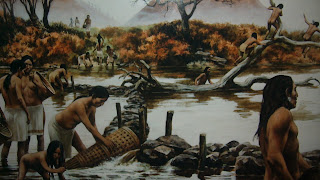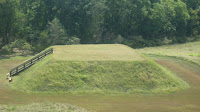 Click title above to view official website
Click title above to view official website The Etowah Indian mounds, located near Cartersville, GA north of the Etowah River, is the largest Native American settlement in the Etowah Valley. Used from 900 to 1550 A.D., the 54-acre site consisted of six flat burial mounds, a central plaza, a large Daub and Wattle village, defensive ditch, agricultural area, and fish trap (pictured left).
The Spanish explorer, Hernando Desoto, visited the site in August 1540 as he proceeded along what is known as the Desoto Trail, which began in Florida and winded throughout the Southeastern states. Unfortunately, European diseases; such as, measles and smallpox, followed the expedition and quickly decimated the Indian population, leading to the abandonment of the Etowah settlement. Afterward, the once vibrant mound building society of the southeast had left the site with its decendents becoming known as the Creek Indians. Failing to pass on their history to future generations, both the Creeks and Cherokee Indians in the region had forgotten who had built the imposing mounds. Archaeological excavations and research have only recently began to shed light onto this amazing civilization.
 The State Park
The State Park 813 Indian Mounds Rd., S.W.
Cartersville, GA 30120
(770) 387-3747
Weds- Sat 9a.m-5p.m.
Admission 3.50-6.00 (free parking)
The park was extremely easy to locate because there are numerous sign posts leading from Interstate 75 through Cartersville to the site. Entry to the park is through the Museum where admission is paid before proceeding further. Make sure to use the facilities before you start because there are no others on the 54 acre site! I also advise visitors to either bring water or purchase water for the long day in the sun and the climb up the Indian mounds. From the building housing the museum, visitors are greeted by a replica of a Wattle and Daub hut.


Volunteers working along side park rangers helped construct the replica Wattle and Daub hut. Made of sticks, Georgia red clay, and grass, the hut could sleep up to 8 people. The huts included woven benches, an open roof, and a fire pit in the center.


 From here we crossed a bridge over the defensive ditch that surrounds the entire 54 acre site to a half mile path which leads through the Indian village to the village plaza in front of the Temple mound(mound A). There is also an alternative mile long hiking path that follows the defensive ditch around the entire site.
From here we crossed a bridge over the defensive ditch that surrounds the entire 54 acre site to a half mile path which leads through the Indian village to the village plaza in front of the Temple mound(mound A). There is also an alternative mile long hiking path that follows the defensive ditch around the entire site.Moving along the path, we had to imagine numerous Wattle and Daub huts scattered across the village as we moved closer to the Temple mound. The current site is only a large open field, however, the park has sign posts along the path describing the daily activities of the Etowah people.




Once the base of the mound is reached, visitors can look to the left and view the clean swept plaza. Once surrounded by a low rock wall, the Etowah Indians used the area for games, trade, and ceremonies.
As visitors turn to face the Temple mound (Mound A), they can start to appreciate its size and the amount of work and time the Etowah people put into it. Especially, as visitors stare up from the bottom of the steps. If the quarter mile walk wasn't too much, visitors can brave the 132 step climb to the top(approx. 6 stories high). The lucky ones will make it to enjoy the panoramic views of the additional mounds, the outline of the central plaza, the village area, the defensive ditch, the river, and the surrounding countryside.
The mound was used to house the chief and his family, and for presiding over ceremonial services below in the plaza. With the exception of the steps, the mound has never been excavated. Mound B, located directly south of the Temple mound, was used to house a lesser chief and may have been use as a counsel meeting place. Mound C, located southwest of the Temple mound, has been completely excavated and rebuilt, supplying researches with clues into the lives of the Etowah people.












 Down in the Etowah River, visitors can view a replica of an Indian fish trap.
Down in the Etowah River, visitors can view a replica of an Indian fish trap.After visiting each of the mounds, visitors can picnic alongside the river's edge at one of the many picnic tables provided by the park. In addition to the the picnic tables, the park has several riverside benches for relaxing. The best place to relax is in the wooden swing found by the Etowah River.
After eating, visitors can stroll along the river on the shaded perimeter trail, which hugs the defensive ditch all the way back to the museum.
The Museum

Visitors returning from the site are greeted by an authentic replica of an Indian dugout canoe. Using a tree collected from the Etowah River, park rangers burned and scraped the canoe into shape, using the same techniques as Native Americans.
In the air conditioned museum, visitors can view hundreds of artifacts excavated from mound C, D, and E. Artifacts include pottery, jewelry, cooper tools, pipes, weaponry, and artwork.

Two of the most interesting artifacts, found buried at the foot of mound C, are two stone effigies. Affectionately known as 'Mike and Ike', these stone effigies, one male and one female, have given researchers an insight into how the Etowah people may have looked and dressed.
Another attraction in the museum is a theatre which shows a short film on the native population of Georgia.

Before leaving, visitors should make sure to check out the Native American Weaponry demonstration. It includes everything from prehistoric spears to bows and arrows. The most interesting part of the demo was the atl-atl, an ancient weapon used to launch spears farther and straighter than ever before, allowing prehistoric man to kill large animals without risking harm to themselves. Make sure to check the park schedule for the types of demonstrations and guided tours offered each month.
The Wrap Up
It was an inexpensive way to spend the day as a family. The park rangers were extremely friendly and knowledgeable. We got to learn a lot about Indian culture. The panoramic views from atop the Temple mound were amazing and resting beside the river was nice. Unfortunately, the walk, mostly in the direct sunlight, and climb were very strenuous. I suggest visiting in the spring or early fall, skipping the smoldering Georgia summer days. Purposely absent are any pictures of the artifacts inside the museum because I would like visitors to experience how amazing the Etowah culture was for themselves. I hope you have enjoyed this blog post and continue to follow us here at Exploration Southeast.